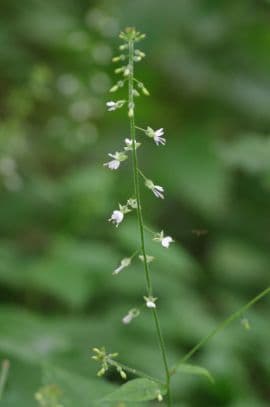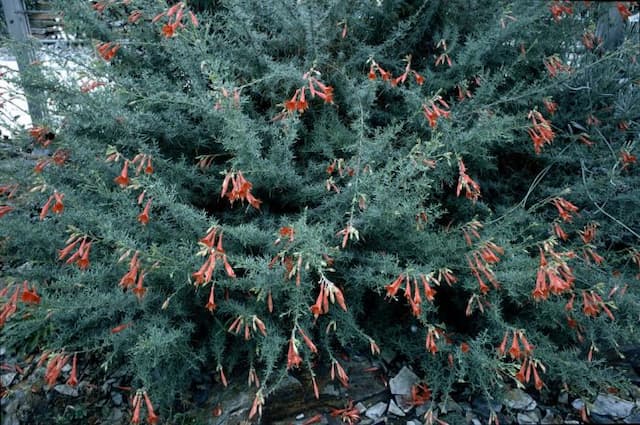Fuchsia Fuchsia 'Bon Accorde'

ABOUT
Fuchsia 'Bon Accorde' is a striking plant that is well-known for its distinctive and ornamental flowers. The blooms dangle elegantly and are composed of two contrasting colors, typically a deep purple or pink outer layer called the sepals, which gracefully curve back from the petals. The inner petals, often in a contrasting shade of pink or violet, elegantly balloon out under the sepals and may be ruffled at the edges. These flowers hang from the plant like decorative lanterns or earrings, giving the plant a festive appearance. The foliage of Fuchsia 'Bon Accorde' adds to its beauty, with leaves that are usually a bright green hue, lending a lush backdrop to the vivid flowers. The leaves might have a slight gloss to their surface and are arranged oppositely or in whorls of threes along the slender stems. These stems can sometimes arch, creating a cascading or weeping effect that is very attractive in hanging baskets or as an accent in the garden. With its showy flowers and attractive foliage, Fuchsia 'Bon Accorde' is a popular choice among gardeners and plant enthusiasts looking for a plant that delivers a visual punch without taking up too much space. Its appearance offers a tropical flair even in temperate climates and is particularly favored for its long blooming season, often from late spring to fall, making it a mainstay in many ornamental gardens.
About this plant
 Names
NamesFamily
Onagraceae.
Synonyms
There are no specific common names for Fuchsia 'Bon Accorde' as it is a cultivar name, but it can generally be referred to as Fuchsia, Lady's Eardrops.
Common names
Fuchsia 'Bon Accord'.
 Toxicity
ToxicityTo humans
Fuchsia, including the 'Bon Accorde' variety, is generally considered non-toxic to humans. Most fuchsias are safe, and some species can even have edible berries. However, it is always wise to be cautious as people may have individual allergies or sensitivities. If ingested in large quantities, it could potentially cause mild digestive discomfort, but serious poisoning is not typically associated with the Fuchsia plant.
To pets
Fuchsia, including the 'Bon Accorde' variety, is generally considered non-toxic to pets such as dogs and cats. While it is not known to be harmful, individual pets may have varying sensitivities, and eating non-food items can sometimes lead to gastrointestinal upset such as vomiting or diarrhea. Always monitor your pets around plants and contact your veterinarian if you observe unusual symptoms after ingestion.
 Characteristics
CharacteristicsLife cycle
Perennials
Foliage type
Deciduous
Color of leaves
Green
Flower color
Mixed
Height
1-2 feet (30-60 cm)
Spread
1-2 feet (30-60 cm)
Plant type
Shrub
Hardiness zones
9
Native area
Central America
Benefits
 General Benefits
General Benefits- Ornamental Appeal: Fuchsia 'Bon Accorde' offers vibrant and decorative flowers with a unique pendulous shape, adding visual interest to gardens and living spaces.
- Attracts Pollinators: The brightly colored blooms attract hummingbirds and butterflies, which play a crucial role in pollination.
- Versatility: It can be grown in pots, hanging baskets, and as a border plant, making it a versatile choice for different garden designs.
- Shade Tolerance: Unlike many flowering plants, fuchsias thrive in partial shade, making them ideal for under-canopy planting or north-facing gardens.
- Long Flowering Period: Fuchsias, including 'Bon Accorde', have a lengthy flowering season from spring to fall, providing long-lasting color and interest.
- Low Maintenance: With basic care, such as regular watering and occasional feeding, fuchsias can be relatively easy to maintain and keep healthy.
 Medical Properties
Medical PropertiesThis plant is not used for medical purposes.
 Air-purifying Qualities
Air-purifying QualitiesThis plant is not specifically known for air purifying qualities.
 Other Uses
Other Uses- Fuchsia 'Bon Accorde' can be used as a natural dye, offering colors ranging from pink to purple for fabrics when processed correctly.
- The flowers of the fuchsia plant can be crystallized and used as edible decorations on cakes and desserts, adding a touch of elegance and unique flavor.
- Fuchsia 'Bon Accorde' can serve as a learning tool in botany classes for studying plant structure, growth habits, and reproductive systems.
- In landscape design, fuchsia plants are often used to create visual interest with their drooping flowers in hanging baskets or as focal points in small garden spaces.
- As a subject for artists, fuchsias can be a challenging and rewarding focus for watercolor painting due to their vibrant colors and intricate petal structures.
- The plant can be used in craft projects, such as pressing its flowers for bookmark creation or to adorn handmade greeting cards.
- Fuchsia can be incorporated into sensory gardens for their textural and colorful appeal, providing an interactive experience particularly for children or those with sensory processing disorders.
- In photography, the striking appearance of fuchsia flowers presents an opportunity for photographers to practice macro photography skills.
- The nectar-rich flowers of the fuchsia can be used to attract and support pollinators like hummingbirds and bees in a wildlife-friendly garden setting.
- Fuchsia 'Bon Accorde' can be utilized in floral arrangements and bouquets to add a pop of color and a delicate, cascading element to the arrangement's overall design.
Interesting Facts
 Feng Shui
Feng ShuiThe Fuchsia plant is not used in Feng Shui practice.
 Zodiac Sign Compitability
Zodiac Sign CompitabilityThe Fuchsia plant is not used in astrology practice.
 Plant Symbolism
Plant Symbolism- Elegance: Fuchsia's delicate, pendulous flowers embody a sense of gracefulness and refinement, making it a symbol of elegance.
- Confiding love: Fuchsia is often gifted as a representation of confiding love, indicating a trustful, sincere relationship between people.
- Tastefulness: The unique appearance and bright, vivid colors of Fuchsia signify a penchant for tastefulness and appreciation of beauty.
- Good taste: Similarly, Fuchsia can symbolize a person's good taste, often in matters of art and aesthetics.
- Overflowing abundance: The way Fuchsia blooms prolifically helps it represent an overflowing abundance, whether it be in love, prosperity, or blessings.
 Water
WaterFuchsias, including the 'Bon Accorde' variety, require consistent moisture and should be watered whenever the top inch of soil feels dry to the touch, which typically means watering about once or twice a week, depending on climate conditions. Provide thorough watering, ensuring that water reaches the root zone, with approximately 16 to 32 ounces for potted plants and up to 2 gallons for in-ground plants, each time you water. During hot, dry periods, more frequent watering may be necessary.
 Light
LightFuchsias like 'Bon Accorde' prefer bright, indirect light or partial shade, avoiding harsh afternoon sun which can scorch the delicate leaves and flowers. A spot that receives morning sunlight with dappled afternoon shade would be ideal for this plant, ensuring it gets enough light without the stress of intense heat.
 Temperature
TemperatureFuchsias, such as 'Bon Accorde', thrive in mild temperatures, ideally between 55 and 75 degrees Fahrenheit. They can survive temporarily outside this range but should be protected from temperatures below 40 degrees to prevent cold damage and above 80 degrees to prevent heat stress.
 Pruning
PruningPrune Fuchsia 'Bon Accorde' to encourage bushy growth and more flowers, remove dead or damaged stems, and shape the plant, ideally during late winter or early spring before new growth begins. Deadheading, or removing spent flowers throughout the growing season, promotes continuous blooming.
 Cleaning
CleaningAs needed
 Soil
SoilFuchsia 'Bon Accorde,' commonly known as Hardy Fuchsia, thrives in a soil mix of loam, peat, and sand, which ensures good drainage and aeration. The ideal pH for this soil mix should range between 6.0 and 7.0, slightly acidic to neutral.
 Repotting
RepottingHardy Fuchsias like 'Bon Accorde' should generally be repotted every two to three years to replenish nutrients and prevent root-bound conditions. Repotting is best done in the spring before new growth begins.
 Humidity & Misting
Humidity & MistingHardy Fuchsia 'Bon Accorde' prefers moderate to high humidity levels, ideally between 60-70%. Maintaining these humidity levels will support robust growth and vibrant blooms.
 Suitable locations
Suitable locationsIndoor
Ensure bright, indirect light and keep soil moist.
Outdoor
Plant in dappled shade, shelter from strong winds.
Hardiness zone
6-11 USDA
 Life cycle
Life cycleFuchsia 'Bon Accorde', commonly known as Lady's Eardrops, begins its life cycle when the seeds germinate in moist, warm soil conditions, emerging as seedlings with characteristic pairs of leaves. As the plant matures and enters the vegetative stage, it develops a bushy structure with many stems and an increasing number of fuchsia leaves. The plant then enters the flowering stage, producing distinctive drooping flowers with a combination of purple and pink hues, which are attractive to pollinators. After pollination, the flowers develop into small, dark berries that contain seeds, completing the reproductive phase. In favorable conditions, the plant may enter a dormant period during colder months, reducing growth and conserving energy. Upon the return of optimal growing conditions, such as in spring, Fuchsia 'Bon Accorde' resumes active growth, beginning a new life cycle.
 Propogation
PropogationPropogation time
Late Spring-Early Summer
The Fuchsia 'Bon Accorde', commonly known as Hardy Fuchsia, is often propagated through softwood cuttings. The best time to take these cuttings is late spring to early summer when the plant's growth is most vigorous. To propagate through softwood cuttings, choose a healthy, non-flowering shoot and cut a piece about 3 to 5 inches long (approximately 7.6 to 12.7 centimeters), making the cut just below a leaf node. Remove the bottom leaves and dip the cut end into rooting hormone powder to enhance root development. Then, plant the cutting in a pot filled with moistened potting mix and cover with plastic to create a greenhouse effect. Keep the cutting in indirect light and maintain the soil's moisture until roots have developed, usually in a few weeks. Once rooted, it can be transplanted to a larger pot or the garden.








![Fuchsia [Electric Lights]](/_next/image?url=https%3A%2F%2Fplants-admin.emdemapps.com%2Fimages%2Fplants%2F%2Fimages%2F604b5ba9b6455.png&w=640&q=75)
